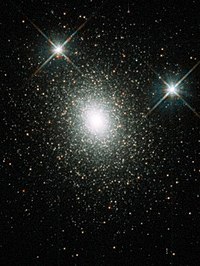
Photo from wikipedia
Stellar-mass black hole binaries (SBHBs), like those currently being detected with the ground-based gravitational-wave (GW) observatories LIGO and Virgo, are also an anticipated GW source for LISA. LISA will observe… Click to show full abstract
Stellar-mass black hole binaries (SBHBs), like those currently being detected with the ground-based gravitational-wave (GW) observatories LIGO and Virgo, are also an anticipated GW source for LISA. LISA will observe them during the early inspiral stage of evolution; some of them will chirp through the LISA band and reappear some time later in the band of $3^{rd}$ generation ground-based detectors. SBHBs could serve as laboratories for testing the theory of General Relativity and inferring the astrophysical properties of the underlying population. In this study, we assess LISA's ability to infer the parameters of those systems, a crucial first step in understanding and interpreting the observation of those binaries and their use in fundamental physics and astrophysics. We simulate LISA observations for several fiducial sources and perform a full Bayesian analysis. We demonstrate and explain degeneracies in the parameters of some systems. We show that the redshifted chirp mass and the sky location are always very well determined, with typical errors below $10^{-4}$ (fractional) and $0.4 \ {\rm deg^2}$. The luminosity distance to the source is typically measured within $40-60\%$, resulting in a measurement of the chirp mass in the source frame of $\mathcal{O}(1 \%)$. The error on the time to coalescence improves from $\mathcal{O}(1 \ {\rm day})$ to $\mathcal{O}(30 \ {\rm s})$ as we observe the systems closer to their merger. We introduce an augmented Fisher-matrix analysis which gives reliable predictions for the intrinsic parameters compared to the full Bayesian analysis. Finally, we show that combining the use of the long-wavelength approximation for the LISA instrumental response together with the introduction of a degradation function at high frequencies yields reliable results for the posterior distribution when used self-consistently, but not in the analysis of real LISA data.
Journal Title: Physical Review D
Year Published: 2020
Link to full text (if available)
Share on Social Media: Sign Up to like & get
recommendations!